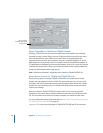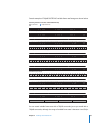
52 Chapter 2 Working with DVCPRO HD
How DVCPRO HD Variable Frame Rate Recording Works
In 720p DVCPRO HD variable frame rate recording, the camera CCD outputs a frame
rate while the recording rate is fixed at either 59.94 fps or 50 fps (depending on the
camcorder model).
A 720p60 camera CCD can generate between 4 and 60 images per second, while the
recording unit records at a constant rate of 60 fps (technically, 59.94 fps). When you
select any frame rate lower than 60 fps, some images from the CCD are recorded more
than once. These redundant frames are tagged for later removal using a special device
called a frame rate converter.
What Is a Frame Rate Converter?
A frame rate converter, or FRC, is hardware or software that converts the frame rate of
your footage by:
 Setting the rate of playback higher or lower, so that each frame lasts a longer or
shorter amount of time on the screen. By changing the duration that each frame is
shown onscreen compared to its recorded duration, you can speed up or slow down
the action in your media.
 Intelligently skipping redundant frames containing variable frame rate flags
Some frame rate converters can also do upconverting and downconverting, allowing
you to use 720p for variable speed cinematography and then transfer to 1080i or 480i
(standard definition).
How a Frame Rate Converter Works
On tape, variable frame rate video footage may look a bit strange—almost
stroboscopic— because many frames are repeated with the intention that they will be
removed. Once the frame rate converter removes the duplicate frames and only unique
frames remain, your footage plays back at the intended rate.
For example, if the camera is set to record 15 fps, three out of every four frames are
tagged as duplicates and the frame rate converter ignores or discards them. The frame
rate converter then converts the 15 fps footage to a new media file at a standard frame
rate such as 23.98, 29.97, or 59.94 fps.


















